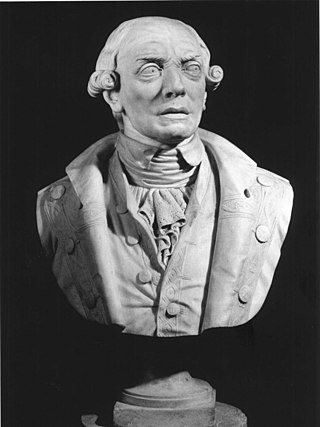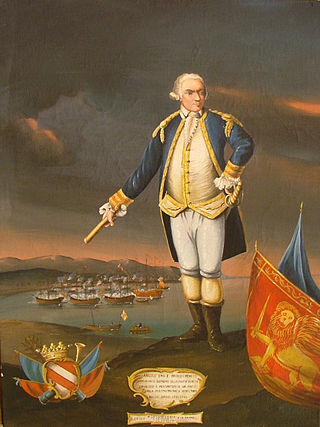Related Research Articles

Angelo Emo was a Venetian noble, administrator, and admiral. He is notable for his reforms of the Venetian navy and his naval campaigns, being regarded as the last great admiral of the Venetian Republic.

The Venetian navy was the navy of the Venetian Republic which played an important role in the history of the republic and the Mediterranean world. It was the premier navy in the Mediterranean Sea for many centuries between the medieval and early modern periods, providing Venice with control and influence over trade and politics far in excess of the republic's size and population. It was one of the first navies to mount gunpowder weapons aboard ships, and through an organised system of naval dockyards, armouries and chandlers was able to continually keep ships at sea and rapidly replace losses. The Venetian Arsenal was one of the greatest concentrations of industrial capacity prior to the Industrial Revolution and responsible for the bulk of the republic's naval power.

The Leon Trionfante class were a class of at least fourteen 70-gun third-rate ships of the line built by the Venetian Arsenale from 1716 to 1785, in four different series with minor changes in the ships' length. In 1797, when Venice fell to the French, Napoleon captured several ships of the class, still unfinished in the Arsenal: he chose one of them, forced the shipbuilders to have it completed and added it to his fleet en route for Egypt. After Campoformio, the remaining vessels were destroyed by the French to avoid their capture by the Austrian Empire.

The Venetian bombardments of the Beylik of Tunis were a series of naval bombardments of the capital and various port cities of the Beylik of Tunis by the Venetian navy in order to force Bey Hammuda ibn Ali to resume the treaty that protected Venetian-flagged shipping from harassment by Barbary pirates. The campaign lasted from 1784 to 1786, with the Venetian navy under Angelo Emo bombarding the harbour towns of Tunisia. The conflict dragged on until 1792, but no major naval actions were undertaken after the winter of 1786/87.
Tommaso Condulmer was a Venetian naval officer and nobleman. After the death of Angelo Emo he took command of the Venetian navy, and held major responsibilities in the aborted defense of Venice against Napoleon's forces which eventually led to the fall of the Republic of Venice in 1797.
The San Lorenzo Zustinian class were a class of at least twenty-nine 70-gun third-rate ships of the line built by the Venetian Arsenale from 1691 to 1746, in three different series with minor changes in the ships' length. It was the most numerous class of ship of the line built in Venice, and the last to see active service in a war against the Ottoman Empire in 1718. All this class' ships were planned before 1720, and the vast majority was launched before the Peace of Passarowitz. The last four vessels were completed to 70% in 1720s, then stored in the roofed shipbuilding docks of the Arsenale to be finished and launched between 1739 and 1746, a solution that was widely used with the following Leon Trionfante class.

The Captain General of the Sea was the wartime commander-in-chief of the Venetian navy.
The Captain of the Gulf was a senior naval command of the Republic of Venice.

The Provveditore Generale da Mar was the most senior peacetime office in the Venetian navy and in charge of governing the Venetian overseas empire.
The governatore dei condannati was a senior commander of the navy of the Republic of Venice. The post initially headed the galley squadron manned by convicts and captives rather than free crewmen.
The Capitano delle Navi was a senior commander of the ships of the line of the navy of the Republic of Venice.

The Capitano Straordinario delle Navi was the senior wartime commander of the ships of the line of the navy of the Republic of Venice.
The Provveditori all'Armar were officials of the Republic of Venice responsible for the provisioning and equipment of the ships and crews of the Venetian navy.
The Giove Fulminante class were the first class of first-rate ships of the line built by the Venetian Arsenal, from 1666 to 1691, armed with 62 to 68 guns. The fifth ship of the class was extensively modified during construction and became the lead ship of the following San Lorenzo Zustinian class. The last ship of the class was retired in 1709.
The Patron delle Navi, also Patrono or Patrona delle Navi, was a squadron commander of the ships of the line of the navy of the Republic of Venice.
San Vincenzo was a large frigate of the Venetian navy. Ordered in 1720 and laid down in 1722 at the Arsenal of Venice, it belonged to the Sant'Andrea class. It entered service in 1730, and was lost due to fire while undergoing repairs at the anchorage at Govino Bay in Corfu, on the night of 11 May 1752. With about 1,500 tons in total displacement, it could be equipped either as a large frigate or as a second-rank ship of the line.
Europa was a first-rank ship of the line of the Venetian navy, serving from 1739 to 1764.
Adria in Pace was a first-rank ship of the line of the Venetian navy, serving from 1739 to 1753.
San Carlo Borromeo was a first-rank ship of the line of the Venetian navy, serving from 1750 to 1768.

Jacopo or Giacomo Nani was an admiral and politician active during the last decades of the Republic of Venice.
References
- 1 2 3 4 Ercole 2022, p. 51 (note 55).
- ↑ Nani Mocenigo 1935, pp. 351–352, 355.
- ↑ Nani Mocenigo 1935, p. 355.
- ↑ Ercole 2022, pp. 51–52 (esp. note 55).
- ↑ Anderson 1952, p. 310.
- ↑ Ercole 2022, p. 53.
- ↑ Anderson 1952, pp. 310–311.